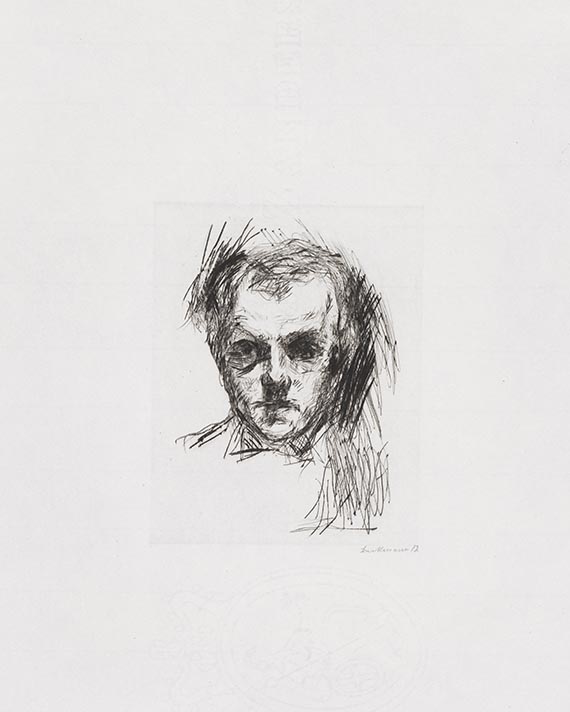124
Max Beckmann
Kleines Selbstbildnis, 1913.
Drypoint
Post auction sale: € 18,000 / $ 21,240
Kleines Selbstbildnis. 1913.
Drypoint.
Signed and dated "12". From an edition of around 50 copies. On JW Zanders wove paper (with watermark). 15 x 11.8 cm (5.9 x 4.6 in). Sheet: 39,3 x 32,4 cm (15,4 x 12,7 in).
Published by I.B. Neumann, Berlin. [AW].
• Self-portraits play a central role in Max Beckmann's work.
• In 1912, the artist turned to etching after having worked exclusively in lithography.
• Expressive frontal view with an intense gaze, reinforced by the deep black tones around his eyes.
PROVENANCE: Dr. J. Lindenberger Collection, Frankfurt am Main.
Galerie Herbert Meyer-Ellinger, Frankfurt am Main.
Karin & Rüdiger Volhard Collection, Bad Homburg (acquired from the above in 1994).
In family ownership ever since.
EXHIBITION: Spektakel des Lebens. Max Beckmann. Arbeiten auf Papier, Sinclair House, Bad Homburg, October 19–December 9, 2001; Museum Folkwang, Essen, February 1–April 7, 2002; Ulmer Museum, Ulm, April 27–June 30, 2002, cat. no. 51.
LITERATURE: James Hofmaier, Max Beckmann. Catalogue raisonné of his prints, vol. 1, Bern 1990, cat. no. 62 II B a (of b).
Klaus Gallwitz, Max Beckmann. Die Druckgraphik, Karlsruhe 1962, catalogue raisonné no. 35.
Drypoint.
Signed and dated "12". From an edition of around 50 copies. On JW Zanders wove paper (with watermark). 15 x 11.8 cm (5.9 x 4.6 in). Sheet: 39,3 x 32,4 cm (15,4 x 12,7 in).
Published by I.B. Neumann, Berlin. [AW].
• Self-portraits play a central role in Max Beckmann's work.
• In 1912, the artist turned to etching after having worked exclusively in lithography.
• Expressive frontal view with an intense gaze, reinforced by the deep black tones around his eyes.
PROVENANCE: Dr. J. Lindenberger Collection, Frankfurt am Main.
Galerie Herbert Meyer-Ellinger, Frankfurt am Main.
Karin & Rüdiger Volhard Collection, Bad Homburg (acquired from the above in 1994).
In family ownership ever since.
EXHIBITION: Spektakel des Lebens. Max Beckmann. Arbeiten auf Papier, Sinclair House, Bad Homburg, October 19–December 9, 2001; Museum Folkwang, Essen, February 1–April 7, 2002; Ulmer Museum, Ulm, April 27–June 30, 2002, cat. no. 51.
LITERATURE: James Hofmaier, Max Beckmann. Catalogue raisonné of his prints, vol. 1, Bern 1990, cat. no. 62 II B a (of b).
Klaus Gallwitz, Max Beckmann. Die Druckgraphik, Karlsruhe 1962, catalogue raisonné no. 35.
124
Max Beckmann
Kleines Selbstbildnis, 1913.
Drypoint
Post auction sale: € 18,000 / $ 21,240
Buyer's premium and taxation for Max Beckmann "Kleines Selbstbildnis"
This lot can be purchased subject to differential or regular taxation.
Differential taxation:
Hammer price up to 800,000 €: herefrom 32 % premium.
The share of the hammer price exceeding 800,000 € is subject to a premium of 27 % and is added to the premium of the share of the hammer price up to 800,000 €.
The share of the hammer price exceeding 4,000,000 € is subject to a premium of 22 % and is added to the premium of the share of the hammer price up to 4,000,000 €.
The buyer's premium contains VAT, however, it is not shown.
Regular taxation:
Hammer price up to 800,000 €: herefrom 27 % premium.
The share of the hammer price exceeding 800,000 € is subject to a premium of 21% and is added to the premium of the share of the hammer price up to 800,000 €.
The share of the hammer price exceeding 4,000,000 € is subject to a premium of 15% and is added to the premium of the share of the hammer price up to 4,000,000 €.
The statutory VAT of currently 7 % is levied to the sum of hammer price and premium.
We kindly ask you to notify us before invoicing if you wish to be subject to regular taxation.
Differential taxation:
Hammer price up to 800,000 €: herefrom 32 % premium.
The share of the hammer price exceeding 800,000 € is subject to a premium of 27 % and is added to the premium of the share of the hammer price up to 800,000 €.
The share of the hammer price exceeding 4,000,000 € is subject to a premium of 22 % and is added to the premium of the share of the hammer price up to 4,000,000 €.
The buyer's premium contains VAT, however, it is not shown.
Regular taxation:
Hammer price up to 800,000 €: herefrom 27 % premium.
The share of the hammer price exceeding 800,000 € is subject to a premium of 21% and is added to the premium of the share of the hammer price up to 800,000 €.
The share of the hammer price exceeding 4,000,000 € is subject to a premium of 15% and is added to the premium of the share of the hammer price up to 4,000,000 €.
The statutory VAT of currently 7 % is levied to the sum of hammer price and premium.
We kindly ask you to notify us before invoicing if you wish to be subject to regular taxation.
Headquarters
Joseph-Wild-Str. 18
81829 Munich
Phone: +49 89 55 244-0
Fax: +49 89 55 244-177
info@kettererkunst.de
Louisa von Saucken / Undine Schleifer
Holstenwall 5
20355 Hamburg
Phone: +49 40 37 49 61-0
Fax: +49 40 37 49 61-66
infohamburg@kettererkunst.de
Dr. Simone Wiechers / Nane Schlage
Fasanenstr. 70
10719 Berlin
Phone: +49 30 88 67 53-63
Fax: +49 30 88 67 56-43
infoberlin@kettererkunst.de
Cordula Lichtenberg
Gertrudenstraße 24-28
50667 Cologne
Phone: +49 221 510 908-15
infokoeln@kettererkunst.de
Hessen
Rhineland-Palatinate
Miriam Heß
Phone: +49 62 21 58 80-038
Fax: +49 62 21 58 80-595
infoheidelberg@kettererkunst.de
We will inform you in time.




 Lot 124
Lot 124 

